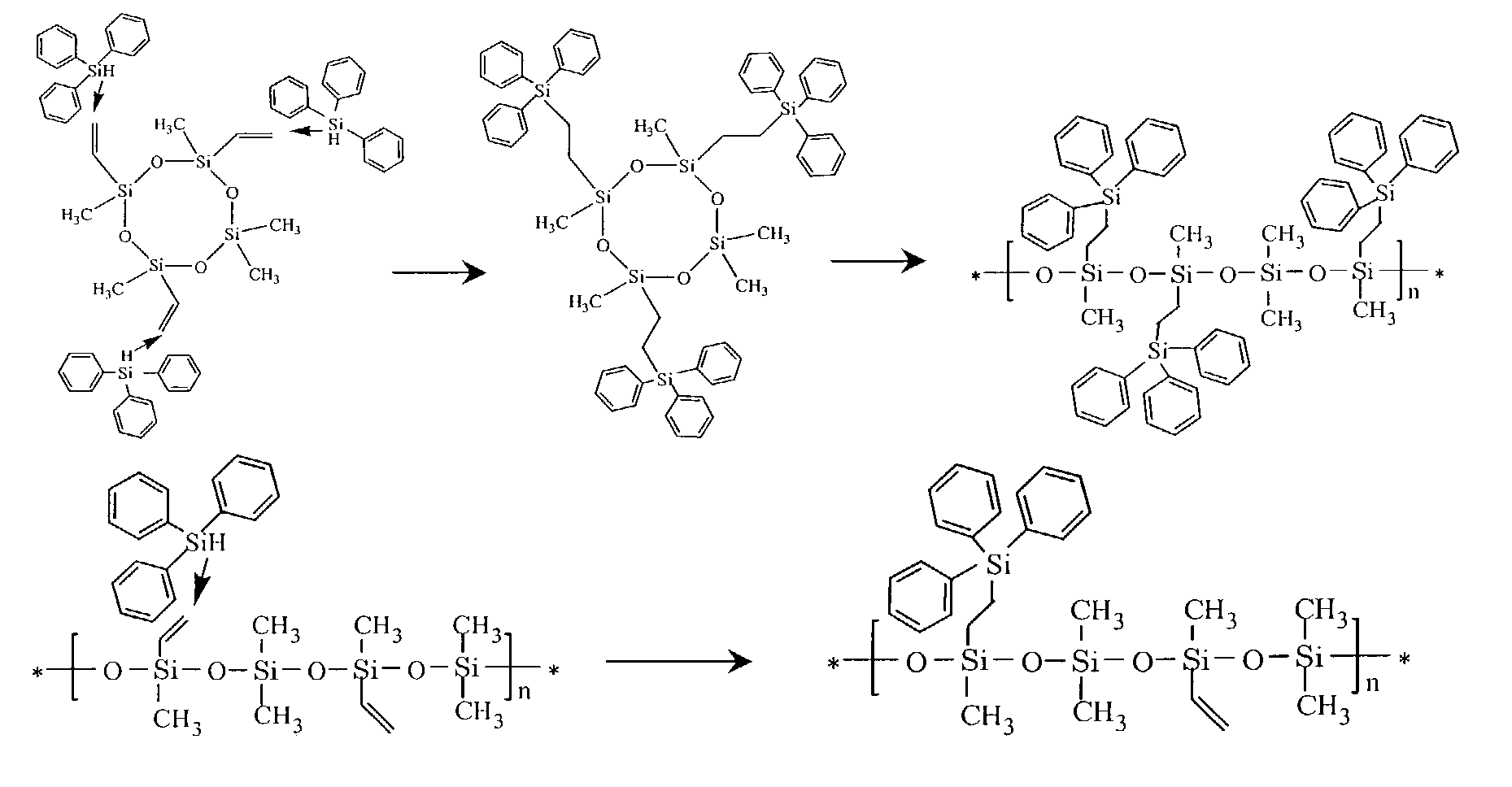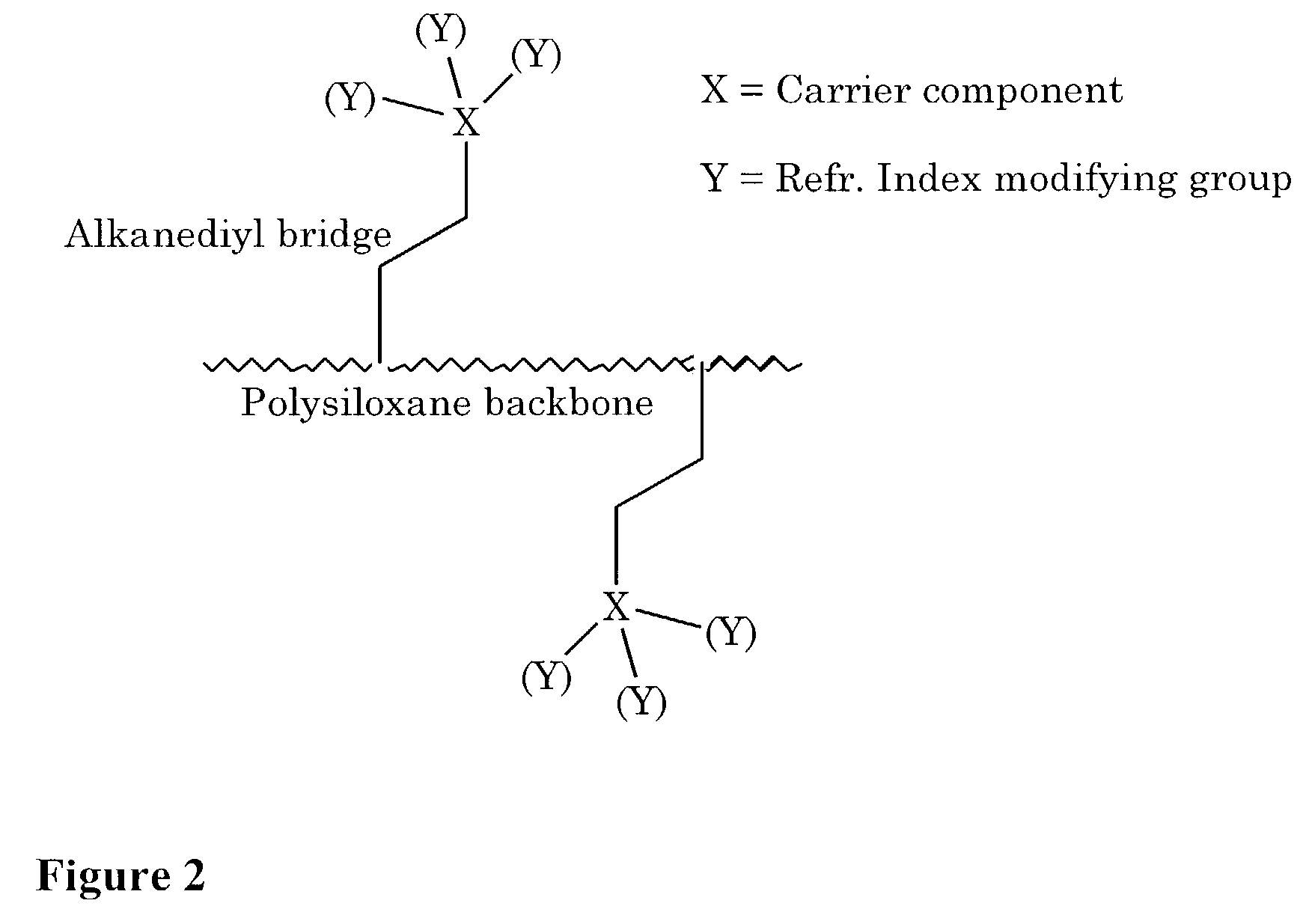High refractive index flexible silicone
a flexible, high-refractive technology, applied in the field of flexible silicone, can solve the problems of limited refractive index of silicone materials, and reduced flexibility or elongation of cross-linked networks of modified polymers, etc., to achieve high refractive index, contribute to the refractive index per modification, and high refractive index
- Summary
- Abstract
- Description
- Claims
- Application Information
AI Technical Summary
Benefits of technology
Problems solved by technology
Method used
Image
Examples
example 1
Monomer Route; Addition to the Monomer
[0110]Tetravinyl tetramethyl cyclo tetrasiloxane and triphenylsilane were mixed in a molar ratio of 1 to 4. An amount of 11 ppm of platinum divinyl tetramethyl disiloxane was added as a 2.5 wt. % solution in xylene. Air was excluded by replacing it with an argon atmosphere and the mixture was heated to 90° C. The mixture was stirred at the reaction temperature for 96 hours. After 96 hours, a small amount of vinyldiethylmethylsilane or another vinylcontaining silane was added and the mixture was stirred at 90° C. under argon atmosphere for 24 hours.
Monomer Route; Purification of the Modified Monomer (Optional)
[0111]After the addition reaction, the mixture was cooled to RT and 2 volume parts of methanol were added. After stirring for 4 hours in boiling methanol, stirring was stopped and the product was allowed to precipitate for 2 hours. Boiling methanol was decanted, 2 volumes of fresh methanol were added and the product was stirred in boiling me...
example 2
Polymer Route: Preparation of the (pre)Polymer
[0118]An amount of 0.025 g potassium silanolate, 6.7 g tetravinyl tetramethyl cyclo tetrasiloxane, 13.3 g octamethyl cyclo tetrasiloxane and an amount of 40 μl divinyl tetramethyl disiloxane were mixed and reacted under argon atmosphere at 100° C. for 96 hours. After cooling to 50° C., 0.025 g of dimethyl vinylchlorosilane was added to the resulting copolymer and reacted under argon and stirring for 24 hours.
Polymer Route: Addition to the (co)Polymer
[0119]To the copolymer an amount of 10 ppm of platinum catalyst and an amount of triphenylsilane (sufficient as to provide 1 mole per mole of vinyl groups in the copolymer) were added. The mixture was stirred under argon atmosphere at 50° C. until 1–5 mole % of vinyl groups were left in the copolymer (determined with NMR analysis).
Polymer Route: Purification
[0120]After the addition reaction the mixture was cooled to RT and 2 volume parts of methanol were added. After stirring for 4 hours in b...
example 3
Manufacturing of an Intra-Ocular Lens (IOL)
[0122]The (co)polymer of example 1 was divided into two aliquots. To one part, hydride functional cross-linker (tetrakisdimethylsiloxysilane) was added in a ratio of 1:1 hydride groups to vinyl groups in the material after mixing of the two parts. To the other part 10 ppm of platinum divinyl tetramethyl disiloxane was added. An amount of 0.1 wt. % of 1,2,3,4-tetramethyl-1,2,3,4-tetravinyl-cyclotetrasiloxane inhibitor, based on the weight of the polymer, was added to the part with the hydride cross-linker, and a benzophenone UV-blocker capable to react with the (co)polymer during the hydrosilylation curing (0.1 wt. %, based on the weight of the polymer) was added to both parts. The two parts were mixed in an extruder and formation of IOL bodies was accomplished by liquid injection molding into a mold at a vulcanization temperature of 110° C. Post-curing was performed in an oven at a temperature of 120° C. for a periods of 2 hours. Highly tra...
PUM
| Property | Measurement | Unit |
|---|---|---|
| refractive index | aaaaa | aaaaa |
| refractive index | aaaaa | aaaaa |
| refractive index | aaaaa | aaaaa |
Abstract
Description
Claims
Application Information
 Login to View More
Login to View More - R&D
- Intellectual Property
- Life Sciences
- Materials
- Tech Scout
- Unparalleled Data Quality
- Higher Quality Content
- 60% Fewer Hallucinations
Browse by: Latest US Patents, China's latest patents, Technical Efficacy Thesaurus, Application Domain, Technology Topic, Popular Technical Reports.
© 2025 PatSnap. All rights reserved.Legal|Privacy policy|Modern Slavery Act Transparency Statement|Sitemap|About US| Contact US: help@patsnap.com



